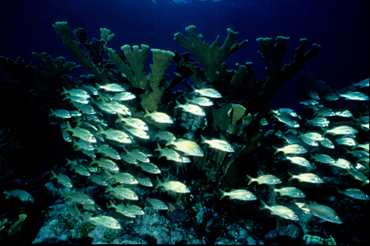We’ve all seen video of large schools of fish moving as one — all of its members seeming to turn, dart, or flow much like a single organism. Marine biologists are still trying to understand how that works — how hundreds or thousands of fish can move together so easily. In other words, they’re trying to work out the rules of the road.
 Schools of fish appear to move together as one. Credit: National Oceanic and Atmospheric Administration
Schools of fish appear to move together as one. Credit: National Oceanic and Atmospheric AdministrationOne recent study found that the rules may be much like those that human drivers are supposed to follow on the highways: keep your eyes on the car ahead of you, and don’t follow too closely.
The study looked at the behavior of mosquitofish — a small freshwater species. Scientists recorded the motions of fish in groups, and used computer models to analyze them. They found that each fish reacted to the one ahead of it. If they got too close — less than about two body lengths — they slowed down. And if they fell behind, they sped up. They also reacted to quick turns by the fish ahead, changing course to avoid collisions and stay in the “sweet spot.”
Such behavior can help the group avoid predators. According to another study, that’s because all the members of the group are scanning for threats, and because each individual only has to watch a small area. Once a single fish spots a threat, it reacts — it tries to get away. The other fish quickly follow that lead, turning and speeding up to avoid the threat. No individual fish is better at spotting threats than any others. Instead, it’s the group that counts — all staying safe by following the rules of the road.

